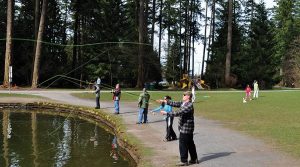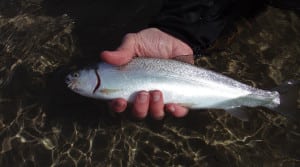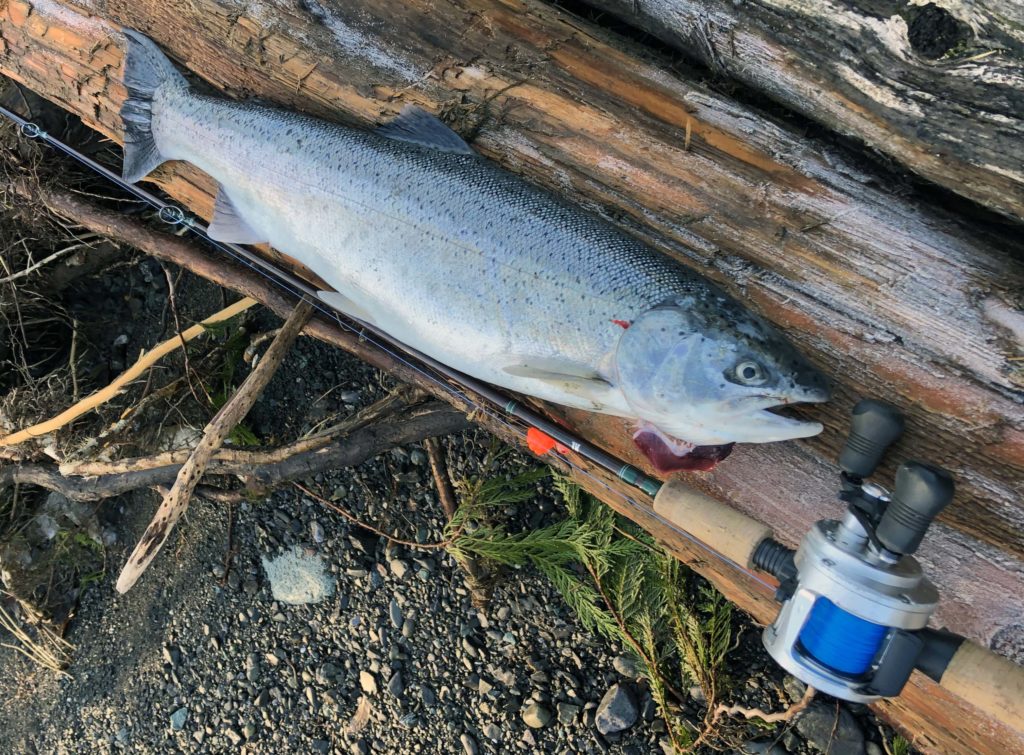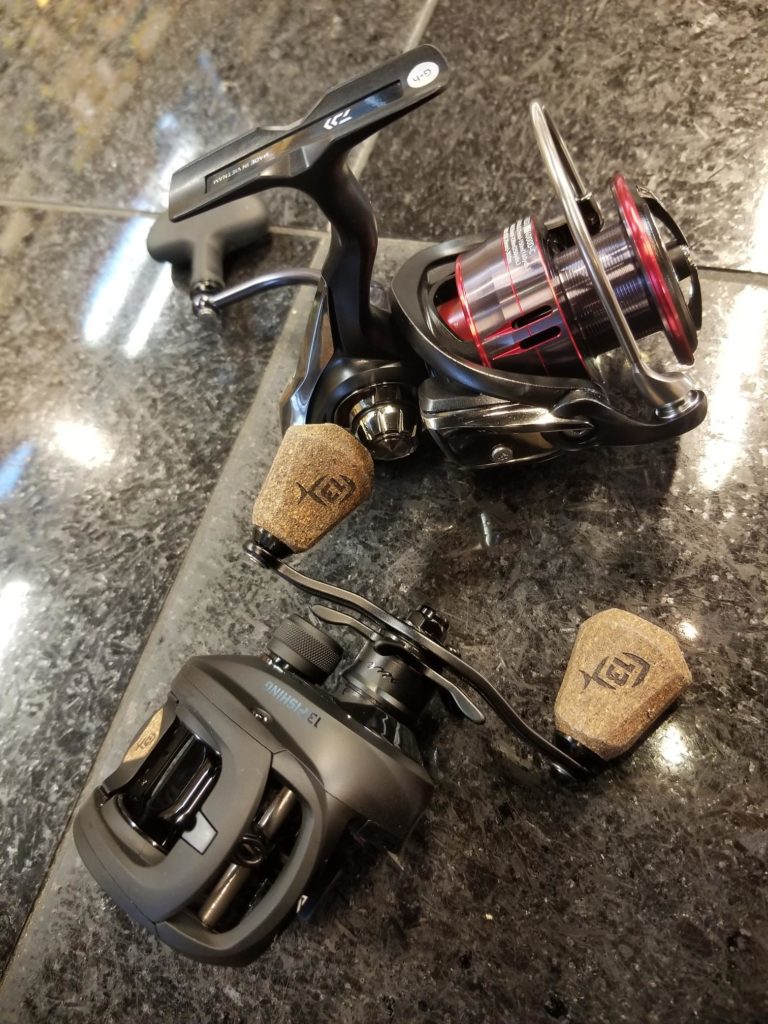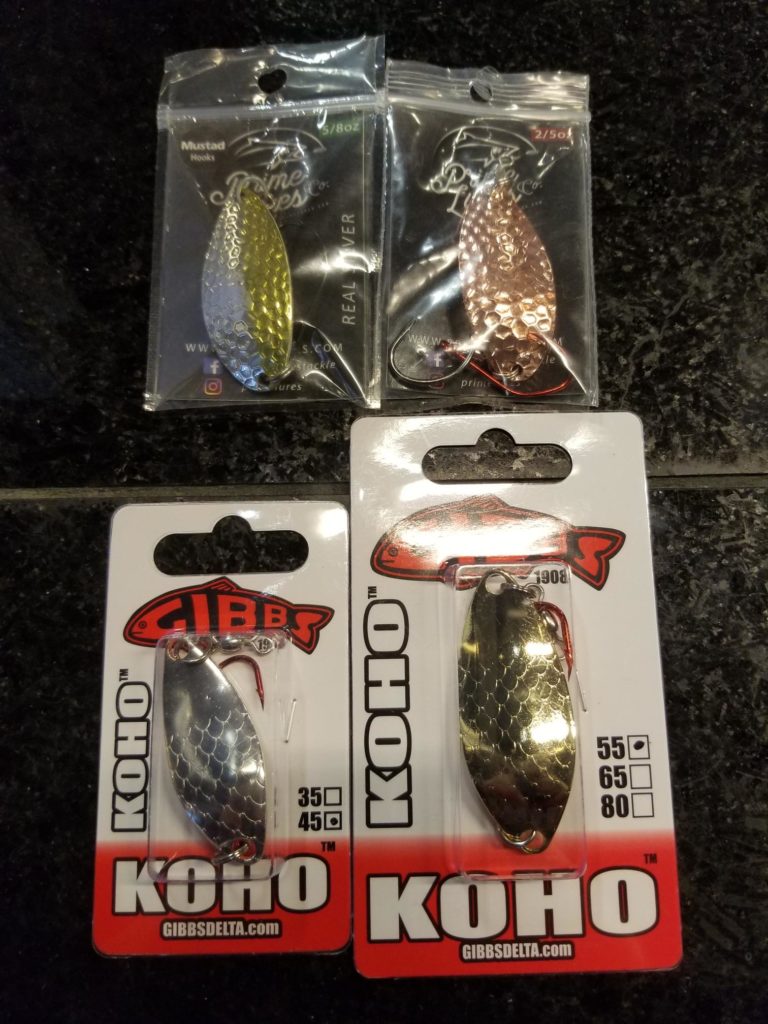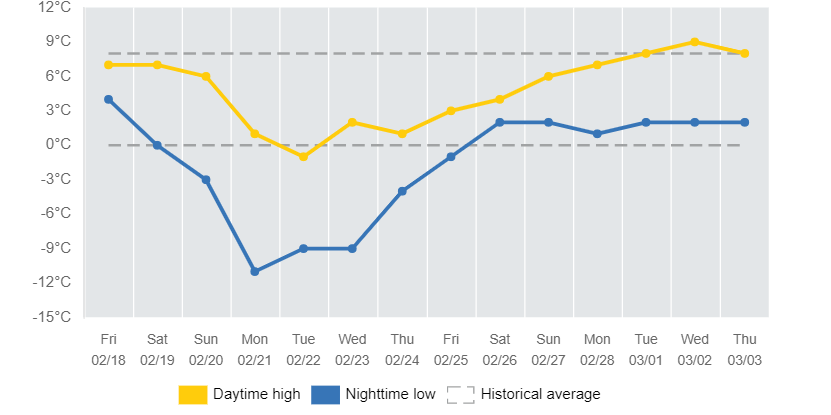OUTLOOK
We want to wish everyone a happy Family Day Long Weekend! We hope you can find some time to take the family out to enjoy mother nature. It looks as though the weather is lining up well, at least for fishing. It may not be as beautiful as last weekend but many of the river systems need water right now. With some rain Friday/Saturday then some sun Sunday/Monday we can expect good fishing conditions.
Positive steelhead reports continue to come in from the valley and we will run through what to expect in the river section of the report. It is also time to start breaking out the spoon rods when steelheading. This is something many hard-core anglers do. Covering a run with a float then switching rods to a spoon, spinner or twitching jig setup gives the fish a different look as it allows you to cover water differently. It’s also nice to have a backup rod when you are out hiking the river. Taylor has a piece on how to pack a second spoon/twitching rod with gear recommendations and fishing tips after the Chilliwack River report.
For those heading the other direction, the Squamish River has been low and clear. The forecast is only for a little rain on Friday with a bit more on Saturday. We are hoping it will be enough to bump levels and color up the water a little.
Lastly, on a freshwater fishing front, we talked about building a circuit of spots to fish for winter steelhead in previous reports and one of the easiest spots to add to your steelhead circuit is the Stave. We have details on this system as well as those mentioned above in the Freshwater Fishing Report Section below.
Winter chinook fishing continues to be steady but we have seen a slight down turn in the size and numbers of fish being caught. That being said, it is still well worth getting out. So, keep an eye on that marine forecast and get out there. We’ll have a full report for you next week.
As a reminder this weekend is Family Day – our long weekend hours are below:
Family Day Long Weekend Hours
Friday February 18 | 10AM – 7PM
Saturday February 19 | 10AM – 6PM
Sunday February 20 | 11AM – 5PM
Monday February 21 | Closed – Happy Family Day!
On to the report!
INDUSTRY EVENTS AND UPDATES
We’re Hiring
There is still time to apply for our open guiding positions for salt, fresh and sturgeon guides. Have a read of our job posting for more details.
CLASSES AND COURSES
INTRODUCTION TO FLY FISHING
This course was specifically designed to give the new fly fisher the basic knowledge, casting skills and fly fishing strategies to effectively fish our local BC waters. This course is comprised of two sessions; 3hr evening seminar and a 3hr casting session. The dates below show the seminar date first and casting date second.
Dates: (Mar 8 & 13), (Apr 6 & 9), (May 10 & 14), (Jun 15 & 18), (July 12 & 17), (Sept 20 & 24)
Cost: $150.00 + GST
Zoom Seminar Time: 6:30pm – 9:30pm
Casting Time(s): 10am – 1pm or 1:30pm -4:30pm
FLY FISHING FOR SEARUN CUTTHROAT TROUT IN RIVERS
This spring make sure to get out and take advantage of the world-class cutthroat fishing in the Lower Mainland. This cutthroat course is designed to educate you on the life cycle, location, seasonal feeding habits, and successful techniques and flies used to catch these elusive yet aggressive fish. This course consists of a 3hr evening seminar and a fully guided day on the water.
Dates: Zoom Seminar Mar 23, 2022
Guided Mar 26, 27, Apr 2 or 3, 2022Zoom
Seminar Only Cost: $50.00+GST
Zoom Seminar & Guided Walk’n Wade Cost: $275.00+GST per angler, minimum of 2 anglers per guided day on the water.
Zoom Seminar Time: 6:30pm – 9:30pm Guided: Full Day
FRESHWATER FISHING REPORTS
Chilliwack/Vedder River Fishing Report
The river continues to drop and is all the way down to 2.08m. The widening of the river after the floods has made it really interesting. 2.08m on the gauge fishes like what 1.75m used to historically fish like. The major difference is that visibility remains quite cloudy. I’ve personally preferred these conditions as the steelhead will continue to sit in 2-3 feet of water if there’s not enough visibility. This has created ample opportunities to fish the entirety of the river and fish aren’t limited to the deeper holes, as in the past, when the water was ‘low’.
The river could use another rain this weekend but hopefully it doesn’t lead to blown water conditions. The river has been taking its sweet time to bounce back from high water events this year. Weather stations are predicting around 20mm of rain. As a reference, the major spike from 2.3 to 2.7m on January 20th was due to 24mm of rain. The minor spike of 2.25m to 2.3m on January 30th was due to 18mm of rain. Basically, every rain event feels like a wildcard on the Vedder. Keep an eye on that gauge to know how severe the rain is impacting the river.
Fish the slower sections closer to shore if the river does bump and gets a lot of colour put into it. The fish will be on the move and should be fairly bitey. Stick to your gooey bobs, beads, worms, float jigs, Colorado blades, and spoons for the best success. Fish should be aggressive with the rain event so cover a lot of water with your favorite presentation and check out Taylor’s piece on spoon rods below because it is time to start throwing big flashy things as a changeup.
Good Luck
Sterling Balzer
Stave River Fishing Report
This past week, the Stave continues to hold at a very fishable level. Not much has changed in the past 3 weeks; anglers continue to have moderate success with trout and whitefish. Float fishing beads and bait still reigns popular until the fry start to pop out. Anglers nymphing beads and stoneflies are having a lot of fun with the whitefish in the system as well.
Around this time of year is when we start to see salmon fry emerge, with the pink fry being the first ones to show themselves. Once a good number of fry are in the system, expect a change in the behaviour of the cutthroat trout. That shift also cues a shift in techniques and gear; time to dust off the ultralight spinning rods and 3-5wt single hands! This is a family friendly fishery that does not include very many barriers like some of the other fisheries we have locally.
The setup is quite simple; an ultralight spinning rod with a line rating of 1-6lb is ideal for this fishery. Lined with a light braid or monofilament, weapons of choice include 3/16 Blue Fox Spinners, #3 Mepps Aglia and 3/16 Gibbs Crocs. My favourite colours include blue, gold, copper and green.
Fly rods in the 3-5wt range are perfect for this fishery. Most of the locations you will find cutthroat feeding in will be rather shallow. Using a floating line will cover most of the situations you find yourself in. It is a good idea to carry a clear intermediate tip or Versa Leader as well. My favourite patterns include Rolled Muddlers, Mickey Finn, Cali Neils in sizes 10-6, typically in olive, natural or blue.
Gavin Lau
Spoon Fishing for Steelhead – Time to Break Out the Second Rod
We’re already more than halfway through February and daytime temperatures are starting to rise. The days are getting longer, the water is getting a touch warmer, and the few chum fry that survived the floods are starting to emerge from the gravel. For some of us, this can only mean one thing – it’s time to start bringing a spoon rod on steelhead outings.
Swinging spoons can be a very productive technique if done properly in the correct conditions. As a general rule, good float fishing water is not good spoon water, and vice versa. As a matter of fact, good spoon water actually has a lot in common with good fly water. Generally speaking, classic spoon water is roughly walking-paced, 2-6 feet deep and wide… The kind of water that would take forever to properly cover with a float but can be covered quickly and efficiently with a spoon.
Spoons can also be fished in pocket water quite effectively but be prepared to lose a lot of hardware. The warmer water temps of late winter/early spring are usually associated with good spoon fishing, but chunks of metal can still be quite productive in the early season as well, so keep that in mind.
Medium-power spinning or casting rods in the 8’-9’6” range are ideal for swinging metal; you’re going to want something that is sensitive enough to telegraph what the spoon is doing, yet strong enough to deal with a large, angry steelie.
A 2500-4000 size spinning reel, or a 150-250 size low profile levelwind would be ideal for this application, as they’re more than durable, yet light enough to comfortably cast all day. I prefer 20-30lb brained mainline, but 10-15lb mono also works decently well. I usually run a 2’ leader of 12-15lb Maxima Ultragreen attached to the mainline with a swivel. I prefer mono leaders over flouro leaders due to the mono’s ability to stretch a bit. This stretch acts as a shock absorber when a fish vibe checks your spoon. Vibe check is the cool kids’ way of saying he slammed your lure.
Fluro has been known to “fail the vibe check”, so to speak, and snap when exposed to sudden, violent strikes.
Good swinging spoons are usually broader and more “oval” shaped… think Gibbs Koho, not Gibbs Croc. These broader spoons tend to produce more “thump” and flash, while their greater surface area lets the current carry them downstream a bit quicker without snagging. Gibbs Kohos and Prime Lures oval spoons are both good options, and I personally like silver, gold, copper, and gold/silver finishes best. Although they’ve been discontinued, Gibbs Ironheads and K-Wobblers are also fantastic options, if you happen to have a couple lying around.
The technique itself is simple enough – cast across or slightly downstream, let the spoon sink, then tighten the line and let it swing across the run. You should feel the spoon “thumping” and occasionally ticking bottom and use a very slow retrieve to hold it off bottom. Once the spoon has completed its swing, let it “hang” at the end of the swing for a couple seconds before you reel it in, as fish will often follow it and smash it on the hang… anybody who’s ever swung a fly should be very well acquainted with this concept.
Spoon strikes are often quite aggressive and self-evident, but fish may also lightly “mouth” or “push” the lure, so a good rule of thumb is to set whenever something feels “off”. One of the spoon’s biggest advantages is its unparalleled ability to cover large amounts of water in a short amount of time, so stay mobile to take advantage of this.
Some people hesitate to bring a second rod because they don’t like the added difficulty of carrying two rods, but there are a couple of transport solutions that can make this less of an issue. Personally, I use a pair of large Fishing Butler rod ties to secure the rod to my sling or hip pack, but any gear straps or rod clips will work. Some newer packs and bags even have built-in rod straps and fishpond makes a great belt rod holder that holds a spinning rod perfectly. Matt has a video he did a few years back on how to pack multiple rods if you want some tips on this check that out here.
Spoons will continue to be effective as winter turns into spring and water temps rise, so it’s certainly worth bringing that second rod from here on out- it opens up a lot of water that would otherwise be passed over; it’s fun, and it can be very productive. Give it a shot, you might be pleasantly surprised…
Taylor Nakatani
Squamish River Fishing report
Conditions are still low and clear on the Squamish system and built-up snow continues to make access challenging. Things have gotten better and with a little rain in the forecast for Saturday we are hoping to see the river levels bump up a bit. That said, it is calling for 10mm and we would like to see 15-25mm to push things into ideal fishing water levels.
If you are getting out you might want to add fry patterns to your kit. It is still early but with warm temps over this last week you might find some salmon fry kicking around. Nymphing alvin patterns are a good thing to try right now as well.
When we look at the long-term forecast, they are calling for one more cold snap mid next week. Temps will drop well below freezing at night. Unfortunately, this will make things even more challenging. The light at the end of tunnel is coming next weekend where we should see a noticeable warming trend.
This is normal for the end of February and we are hopeful for a good warm March. Again, March and April are probably the best two months to focus on the Squamish system.
Good Luck!
Matt Sharp



